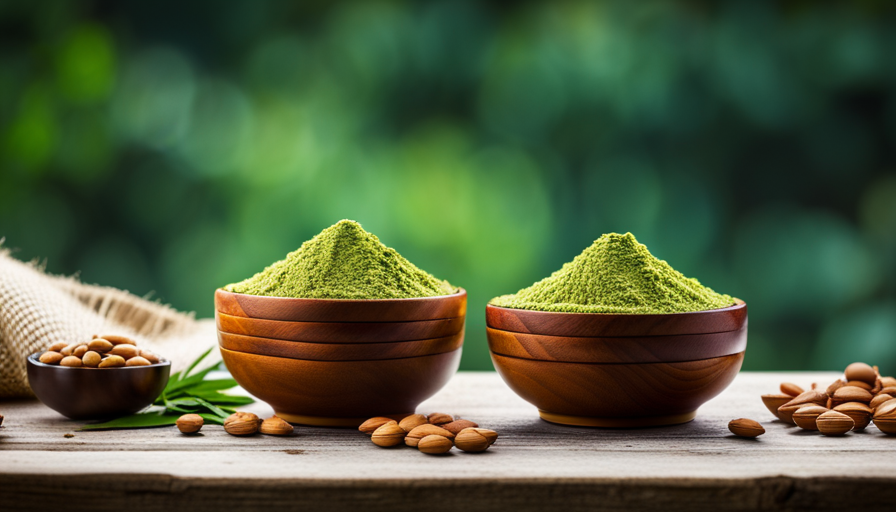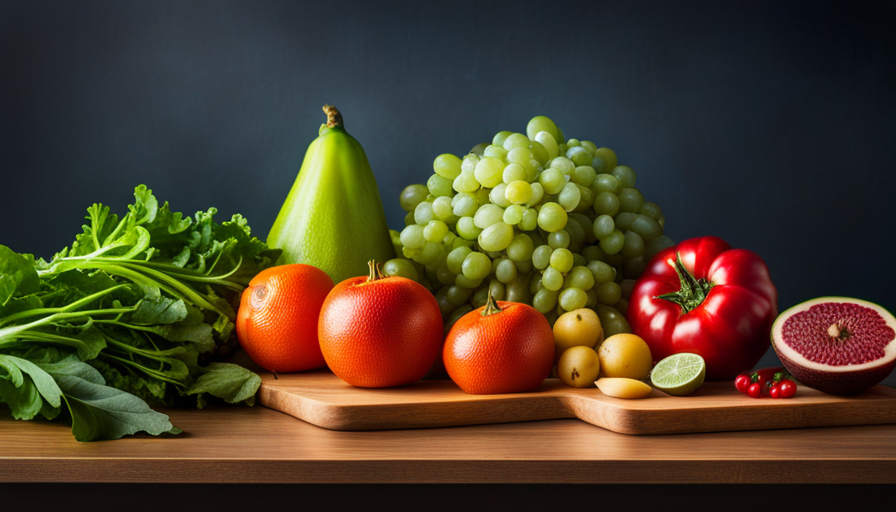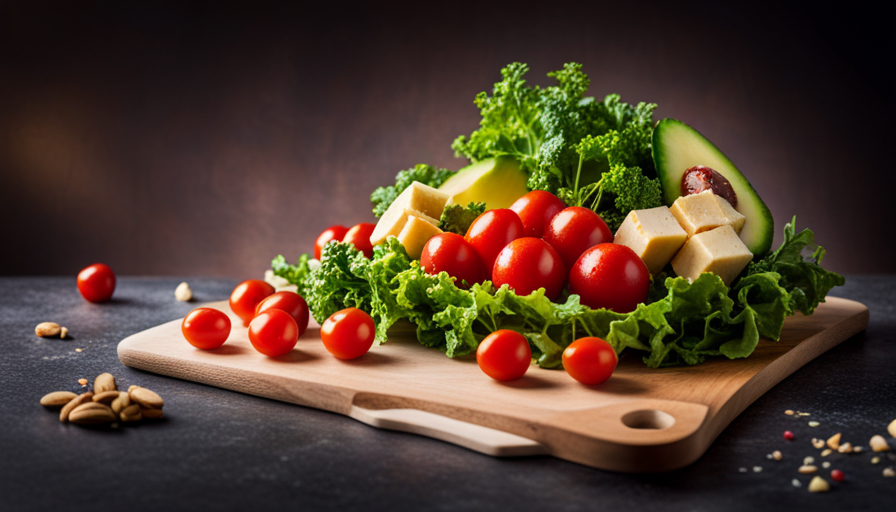Considering trying a raw food diet but worried about getting enough protein? Don’t fret! With the right knowledge and a solid plan, you can easily meet your protein needs while still enjoying the benefits of a raw food lifestyle.
Protein is an essential nutrient that plays a crucial role in building and repairing tissues, supporting a strong immune system, and maintaining overall health. And contrary to popular belief, you don’t need to rely on animal products to meet your protein requirements.
In this article, we will guide you through the world of plant-based protein sources, from nuts and seeds to legumes and sprouted grains. We’ll also introduce you to raw protein powders and teach you how to maximize protein absorption with enzyme-rich foods. Plus, we’ll explore the benefits of incorporating fermented foods for both protein and gut health.
Are you ready to discover how to thrive on a raw food diet while still meeting your protein needs? Let’s dive in and learn how to create balanced, protein-rich meals that will nourish your body and support your well-being.
Key Takeaways
- Raw food diet can meet protein needs with proper knowledge and planning.
- Plant-based protein sources like nuts, seeds, legumes, and sprouted grains are excellent for meeting protein requirements.
- Tofu, tempeh, quinoa, and amaranth are versatile and protein-rich options for a raw food diet.
- Incorporating fermented foods and enzyme-rich ingredients can enhance protein absorption and digestion on a raw food diet.
Understanding Protein Requirements on a Raw Food Diet
To ensure you meet your protein requirements on a raw food diet, it’s important to understand the specific amounts needed for optimal health and incorporate a diverse range of plant-based sources into your daily meals. These sources include nuts, seeds, legumes, and leafy greens. Understanding protein requirements on a raw food diet is key to maintaining a balanced and nutritious eating plan.
One common myth about raw food diets is that they lack sufficient protein. However, this is not the case. While it is true that plant-based protein sources may have lower protein content compared to animal sources, it is still possible to meet your protein needs on a raw food diet. The key is to consume a variety of plant-based protein sources throughout the day.
The recommended daily protein intake for adults is around 0.8 grams per kilogram of body weight. However, on a raw food diet, it is recommended to slightly increase this amount to ensure adequate protein intake due to the lower bioavailability of plant-based proteins. This means that you may need to consume slightly more protein to compensate for the lower absorption rate.
By incorporating a variety of plant-based protein sources into your meals, you can easily meet your protein requirements on a raw food diet. Nuts and seeds, such as almonds, chia seeds, and hemp seeds, are excellent sources of protein. Legumes, such as lentils and chickpeas, are also rich in protein. Additionally, leafy greens like spinach and kale contain a surprising amount of protein.
Understanding protein requirements on a raw food diet is essential for maintaining a balanced and nutritious eating plan. By debunking protein myths and incorporating a diverse range of plant-based protein sources into your meals, you can easily meet your protein needs and thrive on a raw food diet.
Exploring Plant-Based Protein Sources
Explore various plant-based protein sources like legumes, nuts, and seeds to ensure you’re incorporating enough protein into your raw eating plan. These protein-packed foods not only provide essential amino acids but also offer a variety of vitamins, minerals, and antioxidants. Let’s take a closer look at some specific plant-based protein sources that can elevate your protein intake on a raw food diet.
One excellent option is tofu and tempeh. These soy-based products are versatile and can be used in a variety of dishes. Tofu is a great source of protein and also contains calcium and iron. Tempeh, on the other hand, is fermented tofu that has a nutty flavor and is rich in probiotics, which can aid in digestion.
Another fantastic addition to your raw food diet is quinoa and amaranth. These ancient grains are not only gluten-free but also packed with protein. Quinoa contains all nine essential amino acids, making it a complete protein. Amaranth, similar to quinoa, is also a complete protein and provides additional nutrients like iron, magnesium, and calcium.
By incorporating these plant-based protein sources into your raw food diet, you can ensure that you’re meeting your protein needs while enjoying a wide range of flavors and nutrients. So, go ahead and experiment with legumes, nuts, seeds, tofu, tempeh, quinoa, and amaranth to create delicious, protein-rich meals that support your health and well-being.
| Protein Source | Protein Content (per 100g) | Benefits |
|---|---|---|
| Tofu | 8g | High in calcium and iron |
| Tempeh | 19g | Rich in probiotics for digestion |
| Quinoa | 14g | Complete protein with all essential amino acids |
| Amaranth | 14g | Contains iron, magnesium, and calcium |
Incorporating Nuts and Seeds into Your Diet
Add a variety of nuts and seeds to your meals to maximize the nutrient content and enhance the flavor of your plant-based eating plan. Nuts and seeds aren’t just delicious but also great sources of protein on a raw food diet. They’re packed with essential amino acids, healthy fats, and other important nutrients that can help you meet your protein needs.
There are many creative ways to incorporate nuts and seeds into your meals. You can sprinkle them over salads or raw veggie dishes for added crunch and flavor. They can also be blended into smoothies or used as a base for homemade energy bars. Try making a nut or seed butter to spread on raw crackers or use as a dip for fresh fruits and vegetables. Another idea is to use ground nuts or seeds as a coating for raw food recipes, such as ‘raw vegan chicken nuggets’ or ‘raw vegan meatballs.’
Remember to choose a variety of nuts and seeds to ensure that you’re getting a wide range of nutrients. Some good options include almonds, walnuts, cashews, sunflower seeds, chia seeds, and flaxseeds. So get creative and start incorporating nuts and seeds into your meals to boost your protein intake and add delicious flavor to your raw food diet.
Including Legumes for Protein-Rich Meals
If you’re looking to give your taste buds a protein-packed surprise, legumes are the way to go. They’re not only a fantastic source of plant-based protein, but they also offer a wide range of nutrients that can support your overall health. Here are some ways to include legumes in your diet:
-
Lentils: These tiny legumes are packed with protein and fiber, making them perfect for soups, stews, and salads. They come in a variety of colors and cook quickly, making them a convenient option for a protein-rich meal.
-
Chickpeas: Whether roasted for a crunchy snack or mashed for a creamy dip, chickpeas are a versatile legume that can add a protein boost to your diet. They’re also the main ingredient in hummus, a protein-rich spread that pairs well with vegetables and whole grain crackers.
-
Black beans: These legumes are commonly used in Mexican cuisine and are a great addition to tacos, burritos, and salads. They’re not only rich in protein but also provide a good amount of fiber and essential minerals.
-
Peas: Peas are often overlooked when it comes to legumes, but they’re actually a great source of protein. You can add them to soups, stir-fries, or even blend them into protein-rich smoothies.
-
Soybeans: Soybeans are unique among legumes because they contain all nine essential amino acids, making them a complete protein source. You can enjoy them in various forms, such as tofu, tempeh, or edamame.
Incorporating legumes into your diet is a simple and delicious way to increase your protein intake on a raw food diet. Try experimenting with different legume alternatives and protein-rich smoothies to keep your meals exciting and nutritious.
Discovering the Power of Sprouted Grains
Uncover the incredible potential of sprouted grains and watch as they transform your meals into nourishing culinary creations.
Sprouted grains are an excellent addition to a raw food diet, providing a wealth of benefits. When grains are sprouted, their nutrient content increases, making them more easily digestible and bioavailable. This means that your body can absorb and utilize the nutrients more efficiently.
One of the main benefits of sprouted grains is their higher protein content. Sprouting increases the amino acid profile of grains, making them a valuable source of plant-based protein. Incorporating sprouted grains into your meals can help you meet your daily protein requirements on a raw food diet.
There are numerous delicious sprouted grain recipes to explore. You can use sprouted grain flour to make bread, pancakes, or cookies. Sprouted grain salads, wraps, and bowls are also popular choices. By incorporating sprouted grains into your meals, you can enjoy the satisfying texture and nutty flavor they bring, while also reaping the nutritional benefits.
To sprout your own grains, simply soak them in water overnight and rinse them thoroughly. Place them in a sprouting jar or tray and allow them to sprout for a few days, rinsing them regularly. You can then use them in a variety of recipes or dehydrate them for longer storage.
Incorporating sprouted grains into your raw food diet is a simple and effective way to increase your protein intake while enjoying a variety of delicious meals. Start experimenting with sprouted grain recipes today and discover the power of these nutritious culinary gems.
Adding Superfoods to Boost Protein Intake
To truly elevate your protein intake and unleash the full potential of your meals, it’s time to embrace the power of superfoods and incorporate them into your culinary creations.
When it comes to boosting protein on a raw food diet, fruits can be your secret weapon. Not only are they delicious and nutritious, but they also pack a protein punch. Fruits like bananas, avocados, and mangoes are all excellent sources of protein.
One creative way to incorporate these protein-packed fruits into your meals is by making smoothies. Blend a combination of your favorite fruits with some almond milk or coconut water for a refreshing and protein-rich beverage. You can also add a scoop of protein powder or a handful of hemp seeds for an extra boost.
Another way to boost your protein intake is by getting creative with your protein recipes. For example, you can make a delicious raw vegan cheesecake using soaked cashews as the base. Cashews are a great source of protein and healthy fats. You can also make protein balls using dates, nuts, and seeds. These bite-sized snacks are perfect for on-the-go protein fuel.
By incorporating these superfoods and getting creative with your protein recipes, you can easily meet your daily protein needs on a raw food diet while enjoying delicious and nutritious meals.
Creating Balanced Meals with Raw Protein Powders
Creating balanced meals with raw protein powders can add a nutritious and satisfying boost to your culinary creations. Raw protein smoothies and raw protein bars are two delicious and convenient ways to incorporate these powders into your diet.
When making raw protein smoothies, start by choosing a high-quality raw protein powder that suits your taste preferences. Blend it with a variety of fruits and vegetables, such as bananas, berries, spinach, or kale, to create a nutrient-packed smoothie. You can also add a liquid of your choice, such as almond milk or coconut water, to achieve your desired consistency.
For those who prefer a more solid option, raw protein bars are a great choice. You can easily make your own bars at home by combining raw protein powder with nuts, seeds, and dried fruits. Simply mix all the ingredients together, press the mixture into a pan, and refrigerate until firm. These homemade protein bars are not only delicious but also provide a convenient and portable source of protein.
By incorporating raw protein powders into your meals, you can ensure that you are getting enough protein on a raw food diet. Whether you prefer smoothies or bars, these nutritious options will keep you satisfied and energized throughout the day. So, go ahead and get creative with your culinary creations!
Maximizing Protein Absorption with Enzyme-Rich Foods
Boost your protein absorption by incorporating enzyme-rich foods into your meals, allowing your body to efficiently break down and utilize the protein for optimal nourishment. Enzymes are essential for the digestion and absorption of nutrients, and by including enzyme-rich foods in your raw food diet, you can maximize the benefits of the protein you consume.
Here are some ways to enhance your protein absorption:
-
Enzyme supplements: Consider taking enzyme supplements to support your digestion. These supplements contain a blend of enzymes that can help break down proteins and improve absorption.
-
Raw food protein shakes: Add enzyme-rich ingredients like pineapple, papaya, or kiwi to your raw food protein shakes. These fruits contain natural enzymes like bromelain and papain, which aid in protein digestion.
-
Sprouted grains and legumes: Include sprouted grains and legumes in your meals as they are rich in enzymes. Sprouting increases the enzyme content and makes them easier to digest.
-
Fermented foods: Incorporate fermented foods like sauerkraut, kimchi, and tempeh into your diet. Fermentation increases enzyme activity and promotes better digestion.
By incorporating these enzyme-rich foods into your raw food diet, you can optimize protein absorption and ensure that your body receives the necessary nourishment for optimal health and wellbeing.
Incorporating Fermented Foods for Protein and Gut Health
Incorporating fermented foods into your meals can significantly improve your gut health and provide a valuable source of protein. Fermented foods are packed with beneficial bacteria and enzymes that aid in digestion and promote a healthy gut microbiome. These foods also contain a good amount of protein, making them an excellent choice for those following a raw food diet.
One of the benefits of consuming fermented foods is that they help break down and digest proteins more efficiently. The fermentation process breaks down complex proteins into smaller, more easily digestible forms, allowing your body to absorb and utilize the protein more effectively. This is especially important for individuals on a raw food diet, as they may have a higher protein requirement to meet their nutritional needs.
Incorporating fermented foods into your meals is simple and delicious. You can try making your own fermented vegetables, such as sauerkraut or kimchi, using fresh produce and a simple fermentation process. These fermented vegetables can be enjoyed as a side dish or added to salads and wraps for an extra boost of flavor and nutrition. Another great option is fermented soy products like tempeh or miso, which can be used in stir-fries, soups, or as a protein-rich topping for salads.
Incorporating fermented foods into your raw food diet can provide numerous benefits, including improved gut health and a valuable source of protein. Experiment with different fermented food recipes to find the ones that suit your taste and dietary preferences. Enjoy the journey of discovering new flavors while nourishing your body with these nutrient-rich foods.
Planning and Meal Prepping for Protein Success
Plan and prep your meals strategically to ensure you have a protein-packed menu that will leave you feeling satisfied and energized throughout the day. Meal planning is key when it comes to getting enough protein on a raw food diet. By carefully selecting protein sources and incorporating them into your meals, you can meet your daily protein needs.
Start by identifying a variety of protein sources that are suitable for a raw food diet. Nuts and seeds are excellent options, as they’re packed with protein and healthy fats. Incorporate these into your meals by sprinkling them on salads or blending them into smoothies. Another great source of protein is legumes, such as lentils and chickpeas. Soak and sprout them to maximize their nutritional value.
Once you have your protein sources, it’s time to plan your meals. Consider creating a weekly meal plan that includes a mix of protein-rich dishes. For example, you could have a raw nut and seed granola for breakfast, a lentil and vegetable salad for lunch, and a raw veggie wrap with a side of sprouted chickpea hummus for dinner.
By planning and prepping your meals in advance, you can ensure that you have enough protein on a raw food diet. With a well-thought-out menu, you’ll be able to meet your protein needs while enjoying delicious and nutritious meals.
Frequently Asked Questions
Can I meet my protein needs on a raw food diet without consuming animal products?
Yes, you can definitely meet your protein needs on a raw food diet without consuming animal products. There are plenty of plant-based protein sources available to you. Foods like legumes, nuts, seeds, and whole grains are all rich in protein and can easily be incorporated into a raw food diet. It’s important to ensure you’re consuming enough of these protein sources to meet your protein requirements and maintain a balanced diet.
Are there any specific fruits or vegetables that are particularly high in protein?
Some fruits and vegetables are particularly high in protein. For example, spinach, broccoli, and Brussels sprouts are all high protein vegetables that can be included in a raw food diet.
Additionally, certain fruits like avocados and bananas also contain a good amount of protein.
Incorporating these high protein fruits and vegetables into your diet can help ensure you’re meeting your protein needs while following a raw food diet.
How can I ensure I am getting all the essential amino acids on a raw food diet?
To ensure protein balance and optimize amino acid intake on a raw food diet, focus on incorporating a variety of plant-based protein sources. While it’s true that certain essential amino acids may be lacking in individual plant foods, combining different sources throughout the day can provide all the necessary amino acids.
For example, pairing legumes with grains or seeds can create a complete protein profile. By diversifying your food choices and being mindful of protein combinations, you can easily meet your amino acid needs on a raw food diet.
Is it necessary to soak or sprout nuts and seeds before consuming them for better protein absorption?
To ensure optimal protein absorption from nuts and seeds on a raw food diet, it’s beneficial to soak or sprout them before consuming. Soaking removes enzyme inhibitors, making the proteins easier to digest. Sprouting increases the availability of amino acids and promotes the breakdown of complex proteins. Both methods enhance protein absorption and overall nutrient bioavailability. Incorporating soaked or sprouted nuts and seeds into your diet can help you maximize protein intake on a raw food diet.
Are there any risks or potential deficiencies associated with getting protein solely from plant-based sources on a raw food diet?
Protein deficiency is like a ship lost at sea, desperately searching for a guiding light. While a raw food diet can provide ample protein from plant-based sources, there are risks of deficiencies if not approached with care.
Variety is key, as different plant foods offer different amino acids. Incorporate a variety of legumes, nuts, seeds, and leafy greens into your diet to ensure you’re getting a wide range of essential proteins.
Is It Possible to Get Enough Protein and Fat on a Raw Food Diet?
Yes, getting enough fat raw food is possible. Nuts, seeds, avocados, and coconut provide healthy fats. As for protein, legumes, seeds, and nuts are excellent sources. With proper planning and variety, a raw food diet can meet all nutritional needs, including protein and fat.
Conclusion
Congratulations! You’ve now mastered the art of getting enough protein on a raw food diet. By incorporating a variety of plant-based protein sources such as nuts, seeds, legumes, and sprouted grains, you can create balanced and protein-rich meals. Don’t forget to add in some raw protein powders for an extra boost.
Maximize protein absorption with enzyme-rich foods and promote gut health by including fermented foods in your diet. With proper planning and meal prepping, you can achieve protein success on your raw food journey. Keep up the great work and enjoy the benefits of a healthy and nutritious diet.










